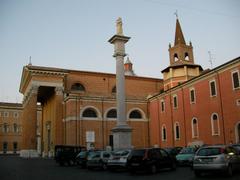
San Mercuriale Abbey Visiting Hours, Tickets, and Historical Sites in Forlì, Italy
Date: 04/07/2025
Introduction to San Mercuriale Abbey in Forlì
San Mercuriale Abbey, prominently located in the heart of Forlì’s Piazza Aurelio Saffi, is one of Emilia-Romagna’s most significant religious and cultural monuments. With origins that reach back to the early medieval era and a Romanesque structure rebuilt in the late 12th century, the abbey offers an immersive journey through centuries of spiritual devotion, artistic achievement, and civic life. Its distinctive 75-meter bell tower—among the tallest in Italy—dominates the city’s skyline, while the abbey’s architecture blends Lombard-Romanesque foundations with Gothic and Renaissance embellishments.
San Mercuriale remains a vibrant hub for religious traditions, especially the veneration of Saint Mercurialis, Forlì’s first bishop and patron saint. The abbey also hosts concerts, art exhibitions, and civic events that enliven its sacred spaces throughout the year. For travelers, art lovers, and history enthusiasts, this guide provides a comprehensive overview of the abbey’s history, architecture, visitor information—including hours, accessibility, and nearby attractions—and tips for a fulfilling visit. For the latest details, refer to the Comune di Forlì Tourism Portal, Summer in Italy, and Religiana.
Contents
- Introduction
- Historical Overview of San Mercuriale Abbey
- Early Origins and Foundation
- Destruction and Rebuilding
- Architectural Evolution
- Cultural and Religious Significance
- Artistic and Architectural Highlights
- Exterior Features
- Interior Layout and Artworks
- Restoration and Preservation
- Symbolic and Civic Importance
- Practical Visitor Information
- Visiting Hours
- Tickets
- Accessibility
- Tours
- Facilities and Etiquette
- Travel Tips
- Nearby Attractions and Events
- FAQ
- Conclusion and Resources
Historical Overview of San Mercuriale Abbey
Early Origins and Foundation
The abbey’s history traces back to the early medieval period, with documented references as early as 962 CE. It was closely associated with the Benedictine monastic movement, which was influential in the region’s religious and civic life. By the late 12th century, San Mercuriale had grown into a key monastic institution, welcoming pilgrims and shaping Forlì’s spiritual landscape (Summer in Italy).
Destruction and Rebuilding
In 1173, the original abbey was destroyed during the Guelph-Ghibelline conflicts. Reconstruction began soon after, culminating around 1181 in the Lombard Romanesque style. This phase introduced thick walls, rounded arches, and the monumental bell tower that defines the abbey today (Religiana).
Architectural Evolution
- Romanesque Foundations: The abbey’s three naves, triple apses, and massive bell tower are hallmarks of its Romanesque origins (Religiana).
- Gothic and Renaissance Additions: The 14th century saw the introduction of a Gothic portal and side chapels, while a Baroque renovation in 1646 brightened the interior and temporarily altered the façade. Subsequent restorations reinstated the Romanesque character (Summer in Italy).
Cultural and Religious Significance
San Mercuriale Abbey has long been central to Forlì’s social, religious, and civic identity. As a minor basilica and pilgrimage destination, it houses artworks and relics of Saint Mercurialis, the city’s patron. Annual festivals, such as the feast of Saint Mercurialis on May 30, continue to draw locals and visitors, blending spiritual tradition with community celebration (Santi e Beati).
The abbey has also served as a hub for education, social welfare, and civic rituals, reinforcing its role as a living symbol of Forlì’s heritage (Forlì Cultura).
Artistic and Architectural Highlights
Exterior Features
Façade and Portal
The façade reflects the sobriety of Lombard-Romanesque design, constructed in brick with minimal decoration. The main portal features a high-relief lunette: “The Dream and Adoration of the Magi,” considered one of Italy’s earliest narrative nativity scenes. The portal itself was remodeled in the 14th century with Gothic arches and columns (Comune di Forlì Tourism Portal; Renato Prosciutto; Catholic Shrine Basilica).
Bell Tower
At 75 meters, the Romanesque bell tower dominates Forlì’s skyline and was celebrated as one of medieval Italy’s marvels. Its tapered, arcaded design influenced later Italian campanili, notably the Campanile di San Marco in Venice (Comune di Forlì Tourism Portal; Renato Prosciutto).
Cloister
The tranquil 15th-century cloister, accessible via a passage added in the 20th century, features elegant Renaissance arcades and frescoes depicting biblical scenes (Visit Romagna).
Interior Layout and Artworks
Nave and Aisles
The basilica plan includes a central nave and two aisles, with exposed brickwork and rounded arches. The interior’s austerity highlights the grandeur and spiritual purpose of the space (Comune di Forlì Tourism Portal).
Chapels and Apse
Gothic side chapels added in the 14th century provide space for private devotion. The apse was rebuilt in 1585, incorporating Renaissance features and more natural light (Catholic Shrine Basilica).
Artistic Treasures
- Frescoes and Paintings: The abbey houses frescoes and paintings by local masters, including Passignano and Tempesta, reflecting transitions from Mannerism to Baroque (The Crazy Tourist).
- Sculptural Highlights: The “Dream and Adoration of the Magi” lunette, sculpted capitals with symbolic motifs, and the marble tomb of Barbara Manfredi showcase the depth of local artistry (Comune di Forlì Tourism Portal).
- Other Works: The 15th-century wooden choir by Marco Cozzi and liturgical silverware further illustrate the abbey’s artistic wealth (Touring Club Italiano).
Restoration and Preservation
The abbey’s present appearance results from extensive 20th-century restoration, which protected its Romanesque core while respecting Gothic and Renaissance additions (Comune di Forlì Tourism Portal).
Symbolic and Civic Importance
San Mercuriale Abbey is not only Forlì’s primary place of worship but also a symbol of the city’s identity. Positioned in the main square, it hosts festivals, markets, and civic ceremonies, bridging sacred and secular traditions (Christian Directory).
The abbey’s architecture and art reflect multicultural influences, including Byzantine, Lombard, and Islamic motifs, and today, the site hosts interfaith events and cultural exhibitions (Italia Nostra).
Practical Visitor Information
Visiting Hours
- Monday to Saturday: 7:30 AM – 12:00 PM, 3:30 PM – 7:00 PM
- Sunday and Religious Holidays: 7:30 AM – 1:00 PM, 3:30 PM – 7:00 PM
Hours may change during festivals or special events; always check the official site before visiting.
Tickets
- Admission: Free. Donations are encouraged to support the abbey’s upkeep.
- Bell Tower: Accessible only during major religious festivals, such as the feast of San Mercuriale (October 26) and Madonna del Fuoco (February 4). Check local announcements or contact the abbey to book in advance.
Accessibility
- Wheelchair Access: The main entrance and nave are accessible. Some chapels and the cloister may have uneven floors or steps. Contact the abbey or tourism office for assistance.
- Facilities: No restrooms on-site; nearby cafes and public buildings offer facilities.
Guided Tours
Guided tours are available on request via the local tourism office or the abbey, typically in Italian, with English tours during peak seasons. Audio guides may be available (Summer in Italy).
Visitor Etiquette
- Cover shoulders and knees.
- Remove hats upon entry.
- Maintain silence, especially during services.
- Photography without flash is permitted except during religious ceremonies.
Travel Tips
- Arrive early to avoid crowds.
- Use public transportation to circumvent parking challenges.
- Combine your visit with nearby attractions for a full day in Forlì.
Nearby Attractions and Events
San Mercuriale Abbey is centrally located, making it easy to explore:
- Piazza Aurelio Saffi: The city’s bustling main square.
- Musei di San Domenico: Art and history museum (8-minute walk).
- Basilica Santuario di San Pellegrino Laziosi: 6-minute walk.
- Palazzo Hercolani: 7-minute walk.
- Parco della Resistenza: 15-minute walk for relaxation.
Throughout the year, the abbey hosts religious festivals, concerts, art exhibitions, and community events. Check the local calendar for special activities (Notte Verde Forlì).
Frequently Asked Questions (FAQ)
Q: Is San Mercuriale Abbey free to enter?
A: Yes, there is no admission fee. Donations are welcome.
Q: What are the visiting hours?
A: Monday–Saturday: 7:30 AM–12:00 PM, 3:30 PM–7:00 PM; Sunday and holidays: 7:30 AM–1:00 PM, 3:30 PM–7:00 PM.
Q: Can I climb the bell tower?
A: Only during major religious festivals by prior arrangement.
Q: Are guided tours available in English?
A: Yes, mainly during peak visitor seasons; otherwise, tours are in Italian.
Q: Is the abbey wheelchair accessible?
A: The nave is accessible, but some areas may be challenging. Contact ahead for details.
Q: Are children welcome?
A: Yes, the abbey is family-friendly, with educational tours available.
Q: Can I take photos?
A: Non-flash photography is allowed except during services.
Conclusion and Visit Planning
San Mercuriale Abbey is a cornerstone of Forlì’s historical and spiritual identity, offering visitors a blend of monumental architecture, rich artistic heritage, and living cultural traditions. With free entry, central location, and a wealth of nearby attractions, it is an essential stop for anyone exploring Emilia-Romagna.
For up-to-date information, visit the Comune di Forlì tourism website, Summer in Italy, or Religiana. Download the Audiala app for guided tours and real-time visitor updates, and follow us on social media for event news and travel tips.
Sources and Further Reading
- San Mercuriale Abbey Forlì: Visiting Hours, Tickets, History & Travel Guide, 2024, Summer in Italy
- San Mercuriale Abbey in Forlì: Architectural Marvel and Visiting Guide, 2024, Renato Prosciutto and Comune di Forlì Tourism Portal
- Cultural and Religious Significance, 2024, Comune di Forlì and Emilia Romagna Turismo, https://emiliaromagnaturismo.it/en/places/forli-cesena/forli/abbazia-di-san-mercuriale
- Visiting San Mercuriale Abbey in Forlì: Hours, Tickets, and Nearby Attractions, 2024, Trek Zone and Comune di Forlì Tourism & Cultura, https://www.scopriforli.it/servizi/turismo_cultura/dettaglio.aspx?ID=139
- Religiana: Abbazia di San Mercuriale Forlì, 2024
- Catholic Shrine Basilica: Basilica Abbey of San Mercuriale Forlì Italy, 2024











